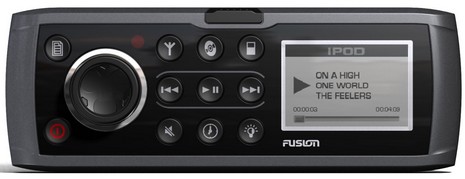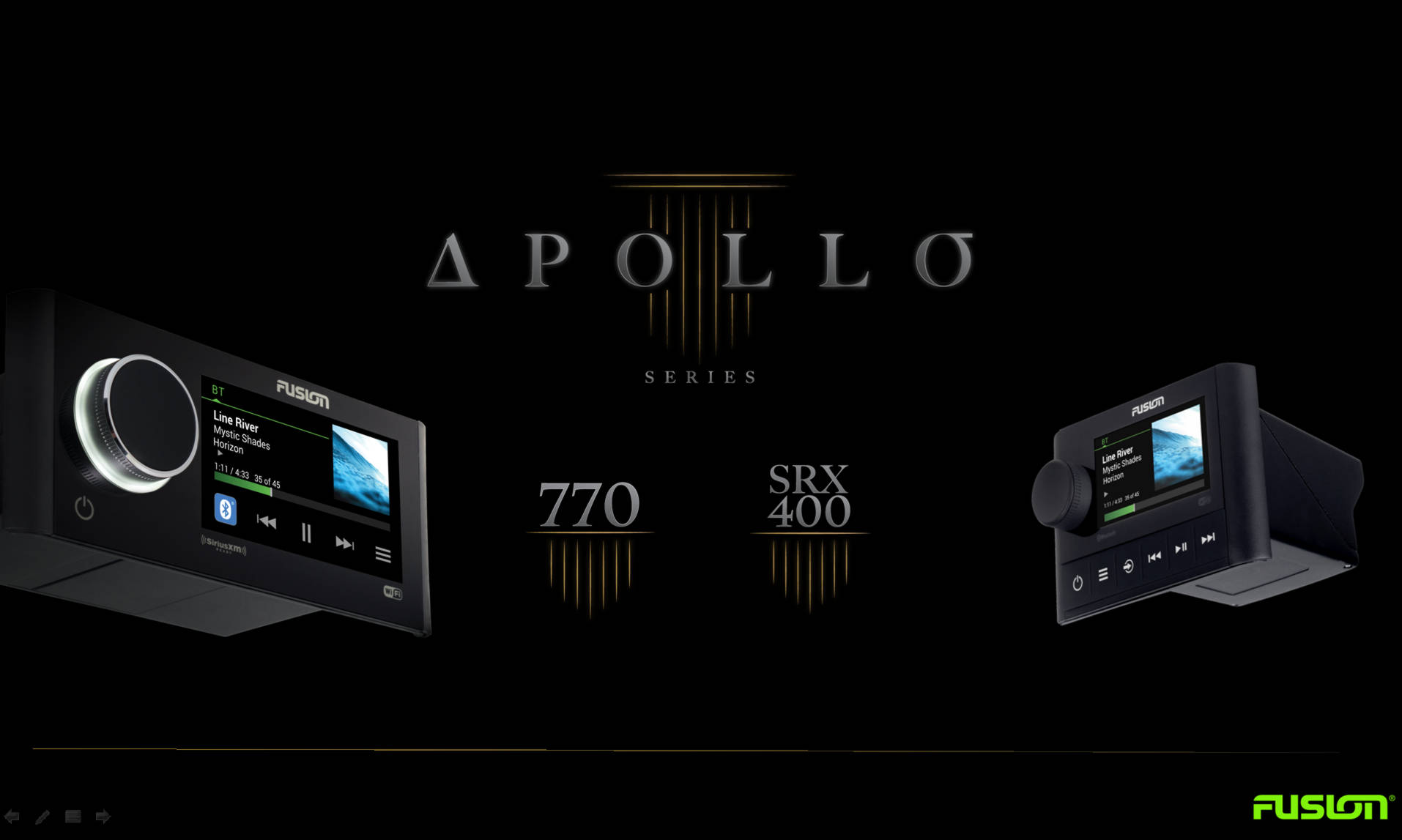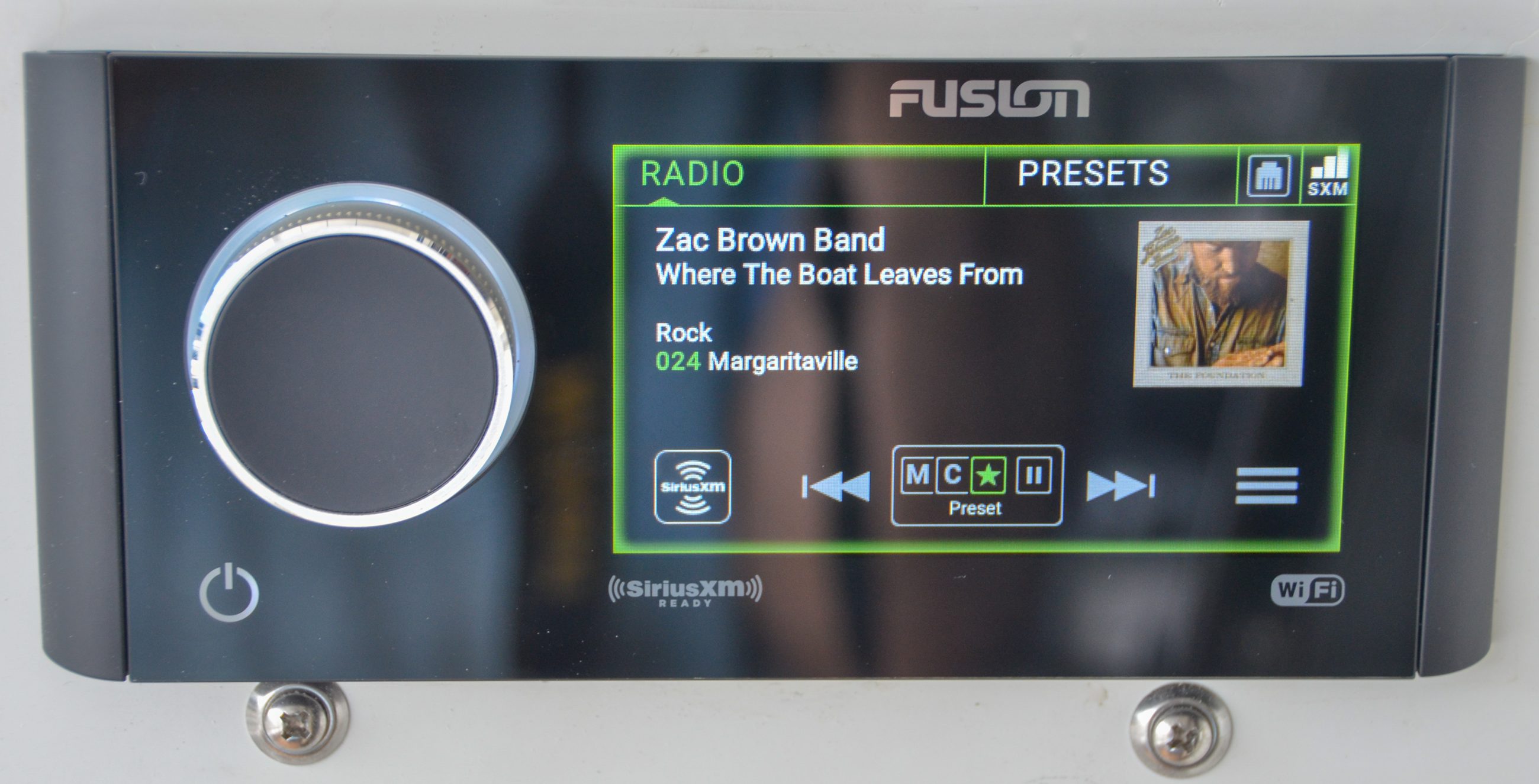SAIL Pittman Awards, one that got away

Above is the MS-IP500 head unit of the full Fusion Marine Stereo system I’ve been testing in the lab. The sound is impressive, even with tracks as wildly dynamic as Wetnurse’s Life at Stake. (Check’em out; my boy Curran is the drummer!) Overall, I think the MS-IP500 is so innovative that it almost earned one of Sail magazine’s 2009 Freeman K. Pittman Awards…
The Pittman Innovation Awards aren’t on Sail’s site yet, but they are in the February issue and there’s a press release here. Like last year, I got to choose and write up four electronics products. It wasn’t an easy decision; the ActiveCaptain Mobile cruiser info sharing system, Furuno’s NavNet 3D nav system, Standard Horizon’s HX850s VHF/GPS handheld, and Navico’s Broadband Radar are all innovative and valuable developments, but the Fusion MS-IP500 is one that got away.
However, I’d say that Fusion is headed into 2009 with another potential winner, namely the MS-AV600 previewed below. I believe it will do everything my test unit does plus play DVDs to two video screens—like maybe your MFD and/or your onboard TV. You’ll need the separate iPod dock, but hopefully this machine will also play iPod video podcasts, TV shows, etc., which could be very cool on a cruise, I think. Hopefully I’ll learn more about the MS-AV in Miami.
PS Other worthy electronics winning Pittmans are Vesper Marine’s AIS Watchmate in the Cruising category and Maretron’s SIM100/ACM100 in Systems.














I’ve been using an Alpine car unit which takes my iPod as input. The sound is fine and it has all the features. The problem is that it’s very tedious to access 300 artists, 800 albums and 8000 songs with a 3 line display.
Does Fusion address that problem with a truly superior UI?
This is an attractive unit but seems too expensive to me. I suppose others will see it differently. I picked up a SONY 820 which sounds fine and does the iPod thing acceptably. It uses a rear mounted dedciated iPod cable and I just lay the device on the nav desk, the shelf or wedge it into the cushions if I expect a roll over. I paid $150. I’m satisfied.
Re: Russ’s Comment
Check out the Vehicle Hub Pro from Alpine which will integrate with your Chartplotter for better ergonomics.
Geoff
Ben – I bought an IP-500, largely on your recommendation, and love it. Still kinda staggering that my boat stereo has a larger hard drive than my primary laptop…
The beauty of this thing in my application is its interoperability with the associated mixer and audio crossbar network, not to mention excellent sound and quick mirroring of the iPod UI. I haven’t measured DC power yet, but it does run much cooler than others I have tried.
Steve
I have a question for those who have an IP500.
Does the iPod get hot, with it being enclosed inside the unit?
Has anyone done a comparison of the power it draws compared to some of the other units mentioned above?
Ric
Ric, My iPod Touch seems quite happy inside the MS-IP500. I have not figured out its power draw, but that’s something I’d like add to my test regime.
Russ, The UI is plain but fast. In my (limited) experience it seems that setting up playlists is the key to using large iTune libraries on anything but a computer.
An idea to capture the Pitman awards next year …
This is a really terrific marine stereo system, but it could be so much better if the long wire runs to the speakers, and their associated weight and complexity, could be reduced.
Perhaps by using wireless technologies to move the music from the stereo head to amplifiers positioned around the boat close to the speakers.
– In addition to the music, include in the wireless signal a two-way communication of information for control multiple zones as a wired configuration would.
– The amplifier modules that receive the bluetooth signal, that are located near the speaker installations, would be powered by12-14v, include jacks for optional miniature remove control receivers (like those that come with car DVD players), and connections of course for the nearby speakers to be connected. Allow for each amplifier to support 1, 2, or 4 speakers from a mix of zones.
– Each speaker on the amplifier module can be designated a zone and a channel (e.g. On one amplifier you can have left speakers for zones 1, 2, and 3, on a second amplifier you can have right speakers for zone 1,2, and on a 3rd amplifier you can have the right speaker for zone 3.). A one speaker amplifier … intended to get sound to an area of the boat that is hard to make a cable run.
– For the remote control receiver jacks in each amplifier module, support up to 3 wired remotes or miniature wireless remote receivers, to provide astonishing wired or wireless remote control coverage — again designating for each remote which zone it controls. (Such remote commands go back to the control head via bluetooth)
Just a thought.
Sorry, I don’t see a need to make something like a fixed marine stereo wireless, and certainly not to avoid “complexity”. There are real complexities to wireless, like device registrations and EMI, and the latter especially on boats.
I’ve heard the same should-be-wireless argument about sensors like depth and GPS, but don’t see it. Much prefer a standard cable networking data and power, like NMEA 2000!
I think boats should have abundant, oversize, and accessible cable runs. Wireless is valuable when cables become a real pain, like for tall mast runs, and for crew moving around deck.
Perhaps I got carried away.
When I wrote, I had in mind premium wireless speakers I use at home which I can pickup and place anywhere on my patio or huge backyard, with speakers that are too good for my boat (to powerful / weight to much). A marine version where the amplifiers can be with the speakers ( instead of crowded into the cabinet with my stereo), powered by 12-14v, and wireless between the amps and the stereo head, is very appealing.
As with my home stereo, I am sure this can be accomplished with external parts, and need not be a feature of the stereo head itself.